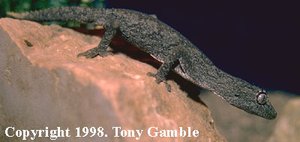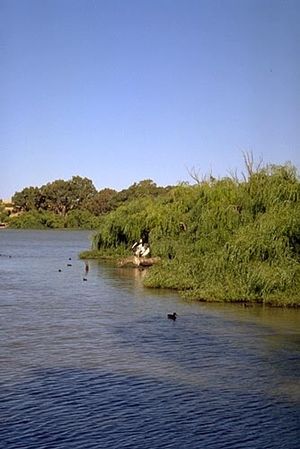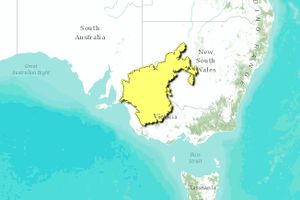Murray-Darling woodlands and mallee
Two of southeastern Australia's most important rivers, the Murray and the Darling, flow though this ecoregion, the Murray-Darling woodlands and mallee. Vegetation consisted largely of eucalypt mallee woodlands, with tracts of riverine vegetation but clearance in the region has been extensive. Despite this, the ecoregion still contains several large tracts of native vegetation, with notable diversity seen among lizards, ants, and honeyeaters (Meliphagidae).
Location and general description
This region lies between the higher rainfall sclerophyll woodlands to the east and south, and the arid chenopod woodlands and shrublands north of the Murray and Darling Rivers. The climate is Mediterranean, with mean annual rainfall declining from around 400 millimeters (mm) in the south to less than 250 mm in the north. The undulating plains of the region are characterized by low parallel sandridges underlain by calcrete, which frequently outcrops in the swales.
Although now extensively cleared for agriculture (predominantly cereal cropping and pasture), the region was originally vegetated with mallee woodlands, a distinctive multi-stemmed growth form emanating from the large lignotubers of Eucalyptus spp. that comprise the tree layer. Understories are often dense and diverse, composed of large Xanthorrhoea tussocks and small-leaved sclerophyllous shrubs (e.g., Acacia, Astroloma, Baeckea, Banksia, Grevillea, Hakea, Leptospermum, Leucopogon, Melaleuca and Pultenea spp.), with a sparse ground cover of grasses, sedges and Lomandra tussocks. In drier areas the understory tends to be sparse and of lower stature, composed of either chenopod shrubs (e.g., Atriplex stipitata, A. vesicaria, Enchylaena tomentosa, Maireana spp., Rhagodia spp.) or Triodia hummock grasses with scattered Zygophyllum spp. shrubs.
The vegetation of the Murray-Darling riverine habitats differs markedly, with black box (Eucalyptus largiflorens) and river red gum (E. camaldulensis) forming woodlands along the river floodplains and terraces. Lignum (Muehlenbeckia cunninghamii) may form thickets in areas that are frequently waterlogged. Away from the water's edge understories include Acacia, Eremophila, and Melaleuca spp., with chenopod shrubs towards the drier margins.
Biodiversity features

Although there are few species endemic to the region, the species diversity of several groups is notable. Lizards are abundant and diverse, especially among Scincidae (Ctenotus, Egernia, and Lerista spp.). Ants are likewise highly abundant and species diverse, particularly in the genera Iridomyrmex, Camponotus, and Melophorus. Given the abundance of nectar-producing plants, it is not surprising that among birds honeyeaters (Meliphagidae) are highly speciated, particularly Lichenostomus and Meliphaga spp. Some 25 species of Eucalyptus have been recorded in the ecoregion, the majority of which possess the mallee habit.
Dry summer thunderstorms are common, particularly in the more northern parts of the region. Consequently, fire is an important large-scale process impacting on biodiversity, and many plant species possess characteristics such as seritony, protected vegetative buds, lignotubers, and soil seedbank that enable populations to persist.
Despite widespread and extensive clearance for agriculture, the region still contains several extensive tracts of vegetation. The largest, the Ngarkat Conservation Park–Big Desert Wilderness Park straddling the South Australian-Victorian border, totals more than 4,000 square kilometers, and constitutes the main stronghold of the endangered black-eared miner (Manorina melanotis) and the vulnerable malleefowl (Leipoa ocellata).
Ecoregion status
Clearance has been extensive and few plant communities in this region are considered to be inadequately conserved. In the South Australian part of the region, some 80 percent of the land has been cleared for agriculture with comparable figures for the adjoining areas in Victoria and New South Wales. The introduction of legislative controls has seen the near cessation of broad-scale clearance. Weeds pose few problems in undisturbed habitats, except where drift or runoff from agricultural lands imports nutrients.
Types and severity of threats
Increasing salinity in the Murray-Darling Basin is a major problem in riverine habitats, and threatens to cause further degradation across large areas in the medium term. Management of fire has been a source of conflict between agricultural landholders and conservation land managers, with pressure for the regular burning of native vegetation as a fire mitigation measure. However, there is a growing recognition of the need to manage fire to create mosaics of differently-aged vegetation. Feral rabbits and goats adversely affect native vegetation, are widespread, and are difficult to control.
Justification of ecoregion delineation
This ecoregion consists of one Interim Biogeographic Region of Australia (IBRA), the 'Murray-Darling Depression' as defined by Thackway and Cresswell. The ecoregion is a transition between wetter sclerophyll woodlands to the east and south, and the arid chenopod shrublands and woodlands to the north.
Further reading
- Boomsma, C. D., and N. B. Lewis. 1980. The native forest and woodland vegetation of South Australia. Woods and Forests Department, Adelaide, South Australia.
- Brouwer, J., and S. Garnett, editors. 1990. Threatened birds of Australia. Royal Australasian Ornithologists' Union, Moonee Ponds, Victoria.
- Chippendale, G. M., editor. 1988. Flora of Australia, Eucalyptus, Angophora (Myrtaceae). Australian Government Publishing Service, Canberra, Australia. ISBN: 0644058668
- Cogger, H. G. 1992. Reptiles and amphibians of Australia, revised edition. Reed Books, Sydney, Australia. ISBN: 0801427398
- Davies, R. J. P. 1982. The conservation of major plant associations in South Australia. Conservation Council of South Australia, Adelaide, South Australia.
- Gill, A. M. 1981. Adaptive responses of Australian vascular plant species to fires. Pages 243-271 in A. M. Gill, R. H. Groves, and I. R. Noble, editors. Fire and the Australian biota. Australian Academy of Science, Canberra, Australia. ISBN: 0858470578
- Glanzig, A. 1995. Native vegetation clearance, habitat loss and biodiversity decline. Environment Australia, Department of the Environment and Heritage.
- Greenslade, P. J. M. 1979. A guide to ants of South Australia. South Australian Museum, Adelaide, South Australia.
- Hilton-Taylor, C. 2000. 2000 IUCN Red List of Threatened Species. IUCN, Gland, Switzerland and Cambridge, United Kingdom. ISBN: 2831705657
- Laut, P., P.C. Heyligers, G. Keig, E. Loffler, C. Margules, R. M. Scott, M. E. Sullivan. 1977. Environments of South Australia Province 2 Murray Mallee. Commonwealth Scientific and Industrial Research Organization, Canberra, Australia. ISBN: 0643002855
- Schodde, R., and I. J. Mason. 1999. The directory of Australian birds: passerines. CSIRO, Melbourne, Australia. ISBN: 0643064567
- Specht, R. L. 1972. The vegetation of South Australia (2nd Edition). Government Printer, Adelaide. ISBN: 0724318607
- Specht, R. L. 1981. Responses to fires in heathlands and related shrublands. Pages 395-415 in A. M. Gill, R. H. Groves, and I. R. Noble, editors. Fire and the Australian biota. Australian Academy of Science, Canberra, Australia. ISBN: 0858470578
- Stove, K. 1998. State of the environment report for South Australia 1998. Page 264. Environment Protection Agency, Department for Environment, Heritage and Aboriginal Affairs, Adelaide, Australia.
- Taylor, R. W. 1991. Formicidae. Pages 980-993 in I. D. Naumann, editor. The insects of Australia: a textbook for students and research workers. Melbourne University Press, Melbourne, Australia. ISBN: 0801426790
- Thackway, R. and I.D. Creswell. 1995. An Interim Biogeographic Regionalisation for Australia: A framework for establishing a national system of reserves, Version 4.0. Australian Nature Conservation Agency, Canberra, Australia.
| Disclaimer: This article contains some information that was originally published by the World Wildlife Fund. Topic editors and authors for the Encyclopedia of Earth have edited its content and added new information. The use of information from the World Wildlife Fund should not be construed as support for or endorsement by that organization for any new information added by EoE personnel, or for any editing of the original content. |

